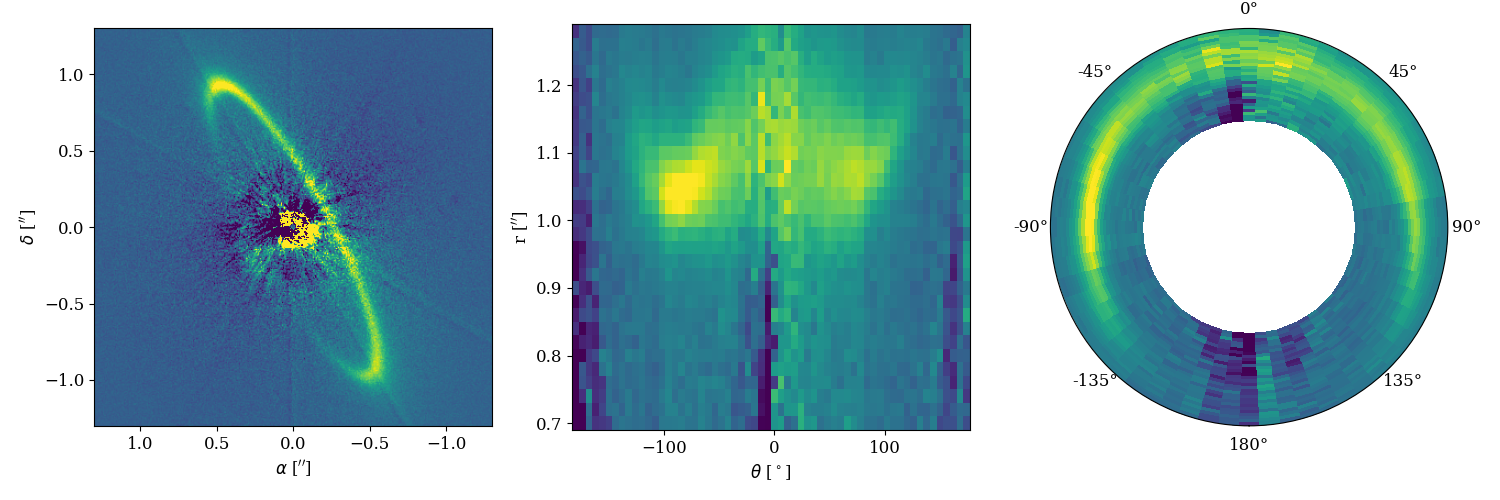A simple tool to deproject direct imaging observations of debris disks.
In principle it could work for any kind of disks that you are interested in, but since the disk is assumed to be vertically flat, it should be more accurate for debris disks rather than proto-planetary disks.
Simply clone the repository and run
python3 setup.py developand you can then import the class with
from deproj import DeprojThe dependencies are numpy, astropy, and matplotlib.
There are very few parameters that you need to provide to get the deprojected map. Here's a quick use example
disk = Deproj('data_example/HR4796_Qphi_400.fits', nr = 30, nt = 60, pixscale = 0.0072)
# disk = Deproj(qphi, nr = 30) # Alternative way to initialize with a 2D arrayThe first argument should either be the name of the fits file containing the observations or directly a 2D array. The observations should have the same number of pixels in both directions. Then, there are the following optional parameters that you can pass:
nr = 30 # Number of radial bins
nt = 60 # Number of azimuthal bins
pixscale = 0.0072 # Size of one pixel in arcsecAfterwards, you can call the main method as
disk.go(amin = 0.7, amax = 1.3, incl = 77.72, pa = -151.59)where the parameters are
amin = 0.7 # The inner radius of the mask
amax = 1.3 # The outer radius of the mask
incl = 77.72 # The inclination of the disk
pa = -151.59 # The position angle of the diskand this will produce the following output:
There are additional parameters that can be passed to the go method:
vmin = 1. # The lower percentile for vmin
vmax = 99.5 # The upper percentile for vmax
cmap = 'viridis' # The colormap
plim = 1.1 # The extent when plotting the observations (in arcsec)
plot = 'full' # What to plot, can be either 'full', 'polar', or 'cartesian'To help you better visualize how this works you can also call the following method
disk.debug(amin = 0.7, amax = 1.3, incl = 77.72, pa = -151.59)which will produce the output below
where you can see on the left the distance in the midplane, with the contours showing the inner and outer radii of the mask, while the right panel shows the azimuthal angle in the midplane. The distance map will be binned in nr cells, and the azimuth map will be binned in nt cells. Since the inclination and position angle of the disk is accounting for in both maps, the deprojection is quite straightforward to do.
The quality of the deprojection will depend on the values for the inclination and position angle that you provide. As you can see in the example above, the deprojected disk does not appear to be very circular. There are two explanations for this, the first one being that the disk has a known eccentricity, which is not accounted for in this package. The second one is that the disk is assumed to be infinitely flat. That example uses the values derived in Olofsson et al. (2022) where we fitted for the vertical scale height of the disk. As further discussed in Olofsson et al. (2020), this can have an impact on your results.
- Install script
- Additional parameters for the plotting,
vmin,vmax,plim,cmapetc - Plotting options, only
polar, onlycartesian,full, etc - Provide either a file name, or a 2D frame directly
- Automatic determination of the inclination and position angle? It would increase the dependencies required though.

